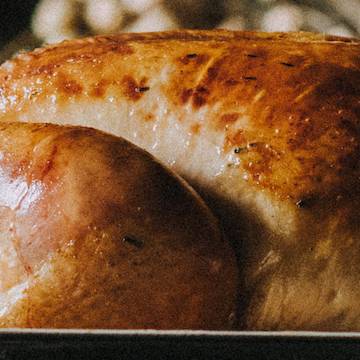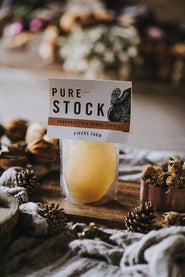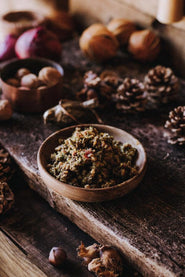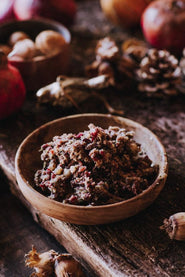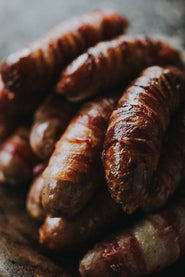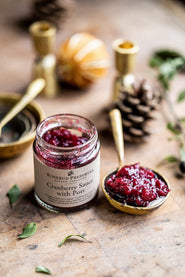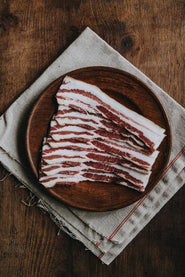Buying your Whole Turkey
It is imperative to check the size of your oven and roasting dish.
We recommend about two portions per kilo.
Our smallest bird at 4.5kg will feed around 8-9 guests. However bear in mind Christmas is a gluttonous time, and the turkey is so delicious, allow yourself half a kilo extra to keep guests sated
Choosing the Stuffing
The carcass can take an array of stuffings. The most harmonious is that of rich fruit, plenty of herbs and a small amount of acidity to cut through the fat. Think lemon or orange zest, diced quince or sharp apple. Sweet apricots, prunes or hedgerow berries. Fatty bacon, breadcrumbs, oats, and barley to help to bind the stuffing. Sage and onion are a must. Onions compliment the sweet meat. Sage with its forest-like pine-notes seems a fitting addition.
Or try one of our handmade stuffings such as Apricot & Hazelnut or Sage & Onion Sausagemeat Stuffing.
Preparing the Turkey
If you can, remove your turkey from the fridge the night before. This allows the turkey to arrive at room temperature. It also gives the skin time to dry off. If you want to create crispy skin with yielding meat, it is imperative the bird is dry.
Take the turkey and pierce the fattiest parts of the underside of the bird. You are aiming to pierce just the skin and fat, without puncturing the flesh. Give the parsons nose a thorough pierce, however, leave the breast intact.
Season the cavity and then fill generously, without overpacking, your choice of stuffing. Season the legs and breast with sea salt and a light twist of black pepper.
Place the bird on a rack and then place the whole thing into a roasting tin. The rack is in place to allow the fat to render in the pan, without stewing the bird. (halfway through cooking you can add roast potatoes into the fat-filled pan)
(There is no need to brine your bird. Because we have taken so much care slow-growing and hanging every Bronze turkey they are succulent and delicious without the need for brining)
How to Roast a Whole Turkey
Preheat your oven to 180C. Let your bird reach room temperature.
Take a good sized roasting dish and let your turkey nestle snugly inside. If the legs overhang simply wrap a bit of tin foil around them and build a trench channelling any liquid back into the pan.
Cook the turkey for approximately 20-25 minutes per kilo.
If you are stuffing your bird simply add the weight of the stuffing to the weight of your bird and calculate the total weight and cooking time. If you are stuffing the cavity add half an hour to your cooking time and make sure you stuff it loosely.
The best indication that your bird is cooked is when it's easy to shake hands with it. Grab a tea towel or an oven glove and gently twist the drumstick to the side. As soon as it 'gives' this is the best indication the bird is cooked. You can also put a skewer into the thickest part of the thigh, the juices should run slightly pink.
Give your bird plenty of time to rest, say 30-40 minutes at room temperature. The ensures the gorgeous juices will stay in the meat rather than run all over your carving board, but be sure to catch any that do emerge and add to your gravy.
The roasting tin may no longer hold the meat but there is so much value left behind. Simply add a pot or two of our pure turkey stock and a good glug of wine then stir to release the hidden treasures. Or make a gravy from scratch using the recipe to follow.
Making the Gravy
Take an onion, red or a shallot is preferable, a chopped carrot, a stick of celery, the goose giblets (minus the liver - this can go to the chef or the dog for a treat), chicken or duck wings, or a poultry carcass, three bay leaves a handful of peppercorns, a pinch of juniper berries and 1.5 litres of water. Bring to the boil and then leave to simmer for an hour. Strain, season and set aside.
Pour in a little fat (not too much, about a tablespoon, as the gravy will become greasy) and some of the cooking juices sat at the bottom of the pan.
Booze and fruit can be added to this base to layer up the festive flavours.
